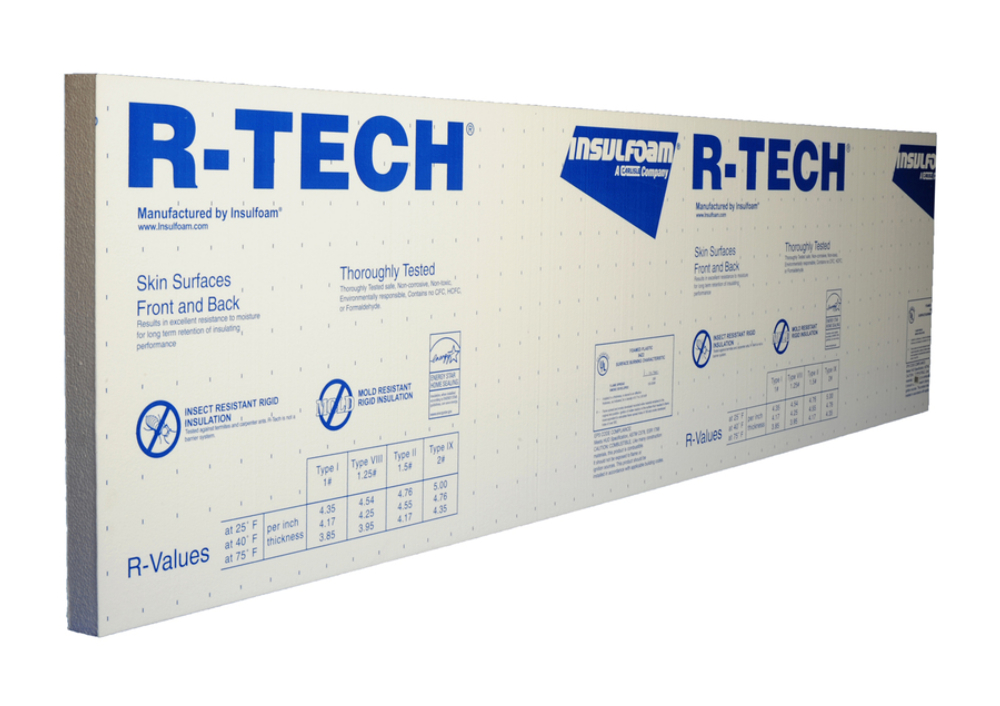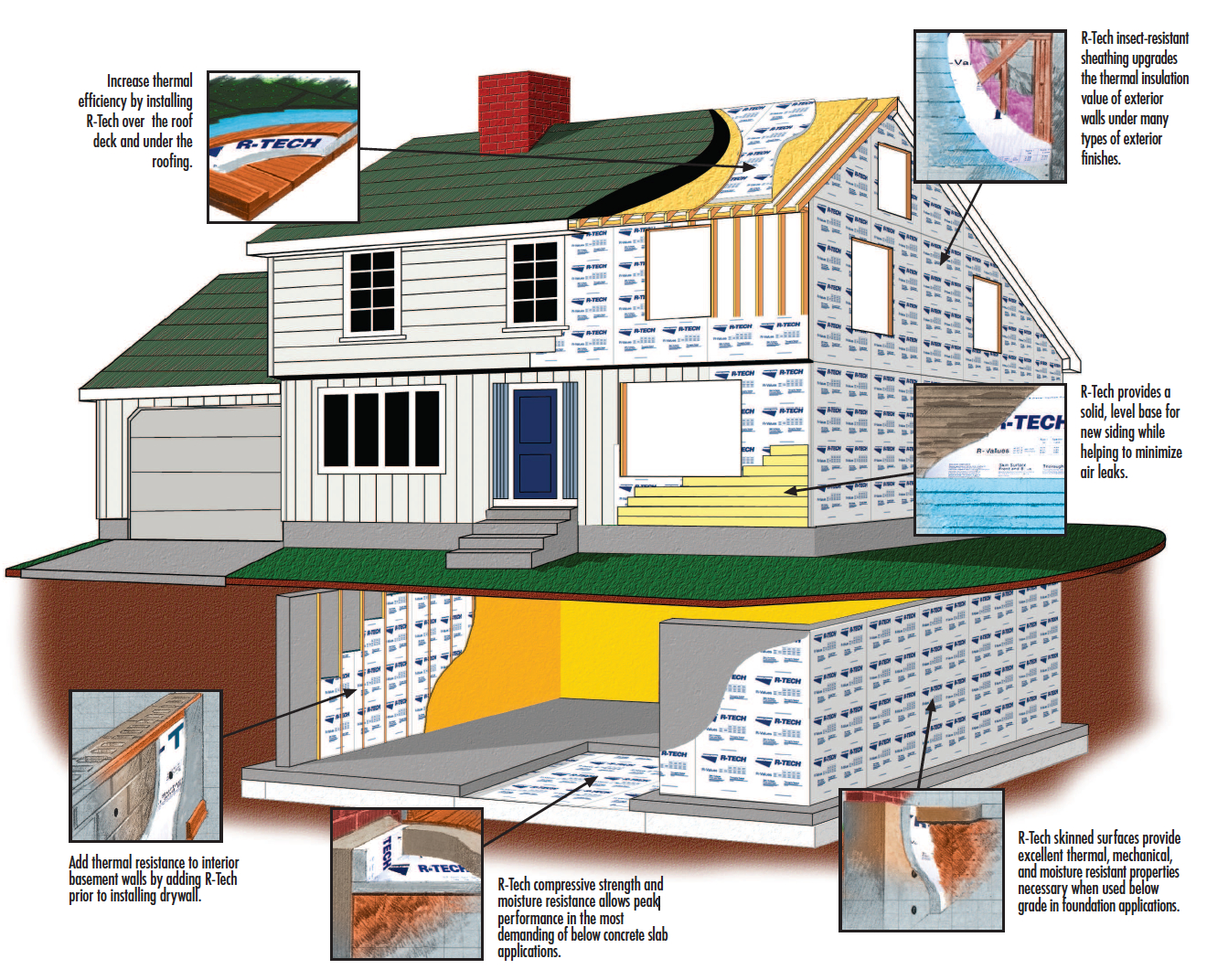There are so many products out there today to help increase energy efficiency of your home. However, insulation remains one of the most critical components and fastest ways to reach this goal, and save on heating and cooling costs. Not to mention making an impact on how much we use (and waste) valuable energy resources. A home should be properly insulated from the roof all the way to its foundation.
 Insulfoam’s R-Tech lightweight rigid insulation panel products are ideal for insulation for the total building envelope (see illustration below). It is also ideal for homeowners looking for a DIY insulation method. Gone are the days of fiberglass splinters, heavy insulation products that are hard to cut, and blown in pieces that take a lot of material for adequate coverage. Adding insulation to the basement, walls, attic, garage or other areas of your home can be do-it-yourself (DIY) projects, with substantial benefits. Homeowners can quickly and economically increase a home’s insulating power with these large lightweight panels that can be cut simply and easily to fit virtually and space.
Insulfoam’s R-Tech lightweight rigid insulation panel products are ideal for insulation for the total building envelope (see illustration below). It is also ideal for homeowners looking for a DIY insulation method. Gone are the days of fiberglass splinters, heavy insulation products that are hard to cut, and blown in pieces that take a lot of material for adequate coverage. Adding insulation to the basement, walls, attic, garage or other areas of your home can be do-it-yourself (DIY) projects, with substantial benefits. Homeowners can quickly and economically increase a home’s insulating power with these large lightweight panels that can be cut simply and easily to fit virtually and space.
Available at home improvement stores nation-wide (Lowe’s and Home Depot), R-Tech comes in various thicknesses, panel sizes and fanfold options (picture unfolding 100 squares insulation in under 5 minutes!) without lose insulation all over, or pesky and painful fiberglass slivers to avoid. See our tips and details below on insulating walls, basement, attic and garage doors.
HOME INSULATING TIPS FOR WALLS AND BASEMENTS
What prep do I need to do for my walls and basement before installing lightweight R-Tech insulation panels?
Before insulating, seal any air leaks and make other necessary repairs. If you are insulating in an area that is located in a conditioned part of the house, also remember to insulate and air seal your basement, wall or attic access.
Next plan and make sure you’re covering all the right areas. Insulate and air seal any knee walls – vertical walls with attic space directly behind them – in your home as well. In addition, if you’re building a new home or remodeling, make sure any area that provides additional storage space or a platform for a heating and/or cooling unit or hot water tank has enough room around them for adequate insulation. Finally, if you live in a hot or warm climate, consider installing a radiant barrier in your attic to reduce summer heat gain.
R-Tech panels easily fold over the top of panel joists without the need to fill in gaps and low spots.
What is the best choice for insulating exterior walls?
Consider using insulating wall sheathing rather than wood sheathing products. These products include foam insulation laminated to a facer or another sheathing product, providing an R-Value of R-2 to R-3.5. With products like R-Tech you can choose thicker foam boards which yields even higher R-Values.
Foam sheathing advantages:
- Provides a continuous layer of insulation, which reduces thermal bridging through wood studs (energy escaping through the wood studs), saving energy and improving comfort.
- Is easier to cut and install than heavier or blown in products.
- Protects against condensation on the inside wall by keeping the interior of the wall warmer.
- Usually costs less than plywood or oriented strand board (OSB).
Basement Insulation Done Right
A properly insulated basement can save you money on heating and provide a dry, comfortable living space. In most cases, a basement with insulation installed on its exterior walls should be considered a conditioned space. Even in a house with an unconditioned basement, the basement is more connected to other living spaces than to the outside, which makes basement wall insulation preferable to ceiling insulation. In fact, up to 25% heat loss occurs through the basements of a home.
In new construction, adding insulation on the exterior of the basement walls will:
- Minimize thermal bridging and reduce heat loos through the foundation.
- Protect the damp-proof coating from damage during backfilling.
- Provide some protection against moisture intrusion.
- Make the foundation part of the thermal mass of the conditioned space, thereby reducing interior temperature swings.
- Reduce the potential for condensation on surfaces in the basement.
- Conserve room area, relative to installing insulation on the interior.
In an existing home, adding insulation to the exterior of the basement walls is impractical. Interior basement wall insulation has the following advantages:
- It is much less expensive to install than exterior insulation for existing buildings.
- Almost any insulation type can be used, some easier and safer to install than others.
- It eliminates the threat of insect infestation.
What else should I consider when installing interior basement wall insulation?
- Many insulation types require a fire-rate covering because they release toxic gases when ignited. Be sure you’re choosing one that complies.
- Interior insulation reduces usable interior space by a few inches. The thinner the product the better.
- It doesn’t protect the damp-proof coating like exterior insulation does, so choosing inflation with a protective facer is a good choice.
- If perimeter drainage is poor, the insulation may become saturated by moisture weeping through foundation walls, be sure to choice an insulation that doesn’t retain moisture.
How much insulation should I add?
Insulation levels are specified by R-Value. R-Value is a measure of insulation’s ability to resist air )hot or cold air) flow. The higher the R-Value, the better the thermal performance of the insulation. R-Tech offers a huge range of sizes and thicknesses to meet the insulation needs your project requires. All with fast and easy insulation. To determine appropriate R-Values for basement walls in your area, use these R-Value recommendations.
HOME INSULATING TIPS FOR ATTICS
How do I know if I need more insulation in my attic?
No matter war kind of insulation you currently have in your attic, one quick way to determine if you need more is to look across the span of your attic. If your insulation is just level with or below you floor joists (i.e., you can easily see your joists), you should add more. If you cannot see any of the floor joists because the insulation is well above them, you probably have enough and adding more may not be cost-effective. It is important that the insulation be evenly distributed with no low spots; something there is enough insulation in the middle of the attic and very little along the eaves. If your attic insulation covers your joists and is distributed evenly, you probably have enough.
R-Tech panels easily fold over the top of panel joists without the need to fill in gaps and low spots.
How Much Should I Add?
Insulation levels are specified by R-Value. R-Value is a measure of insulation’s ability to resist heat flow. The higher the R-Value, the better the thermal performance of the insulation. The recommended level for most attics is to insulate to R-38. A layer of R-Tech is a fantastic way to beef up attic insulation with fast and easy installation. Lay directly over trusses, planks, or subfloor and these large panels can fold out (fanfold) or be joined together with very few gaps for heat/cooling to escape through.
Note the EPA recommends air sealing the attic before adding attic insulation.
DON’T LET ENERGY ESCAPE THROUH YOUR GARAGE
 The largest uninsulated space in most homes is the garage door. Insulfoam’s Garage Door Insulation Kit provides an easy solution for increasing the energy efficiency of your home and reducing interior noise. The kit is environmentally friendly and features a foam core that is 100% recyclable. Insulfoam’s Garage Door Insulation Kit is available at your local Lowe’s and Home Depot home improvement stores.
The largest uninsulated space in most homes is the garage door. Insulfoam’s Garage Door Insulation Kit provides an easy solution for increasing the energy efficiency of your home and reducing interior noise. The kit is environmentally friendly and features a foam core that is 100% recyclable. Insulfoam’s Garage Door Insulation Kit is available at your local Lowe’s and Home Depot home improvement stores.
- Saves energy by reducing heating and cooling costs
- Reduces interior noise
- Clean, professional finished product
- Energy-efficient upgrades may be eligible for federal tax credits
- Simple, easy installation in less than one hour.
View this DIY installation video to see how easy it is to cut and install
3 Comments
-
Hello, nice article where I can buy this foam? And have second question, what about climate? I live in Lithunia where winter is very cold. Does it adapted for – 20C ?
Thanks for answer.-
Hello, you can buy it at most home improvement warehouses or building material manufacturers.
-
-
I appreciate your explanation of how you can tell if there needs to be more insulation in certain spots of the attic. This is because I was dumbfounded when I went up to my attic once only to experience some form of cool spots around the side of the attic while the middle areas were just fine. Since I want to turn my attic into another functioning entertainment room, I’ll address this problem right away and get an insulation company to make sure we have insulation all around it as per your advice.


